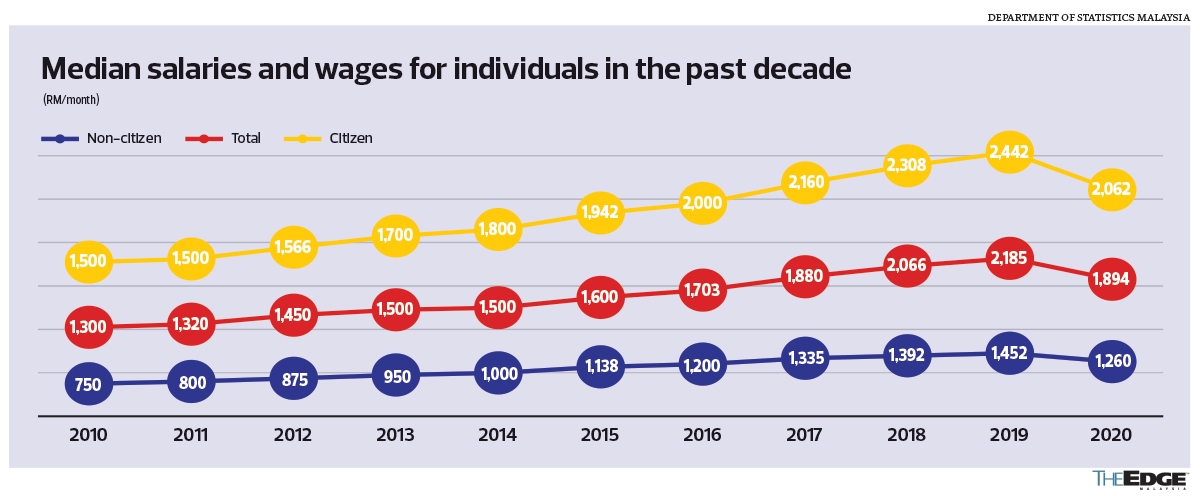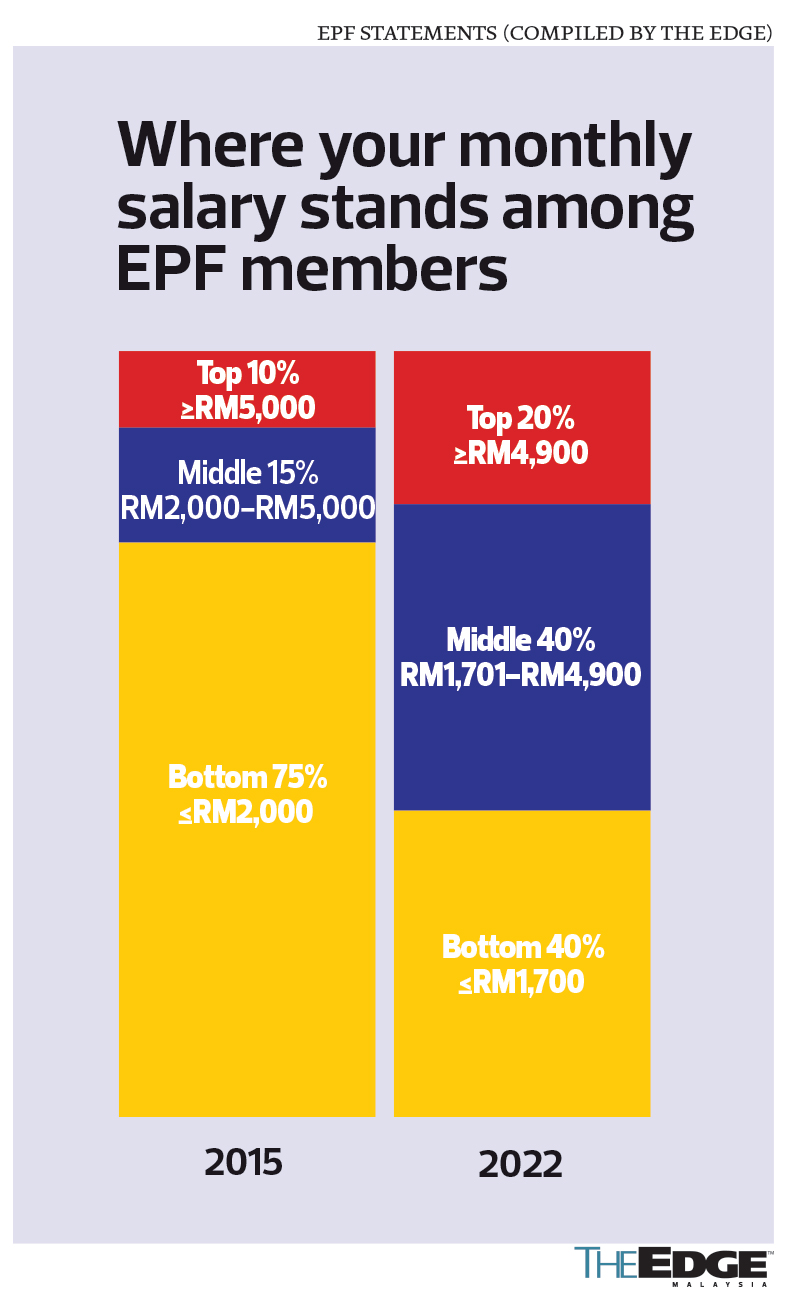
This article first appeared in The Edge Malaysia Weekly on May 23, 2022 - May 29, 2022
THE Employees Provident Fund (EPF) is set to release its performance for the first quarter ended March 31, 2022, between now and mid-June. Apart from how it did in the first three months of the year, attention will be on how its portfolio had been rebalanced to cater for what the fund hopes to be the last Covid-19-related special withdrawal.
Of interest would be whether the amount to be withdrawn under the “up to RM10,000” Special Withdrawal facility (for which payments are made “in batches” from April 18) would be a lot higher than the preliminary figure of RM40.1 billion — which is already double what some economists had expected. According to the EPF’s statement dated April 16, some 5.3 million or 44% of 11.95 million eligible members had applied for it as at April 14 — mostly to supplement (lost) income or pay down debt.
Even with just the RM40.1 billion announced so far for the Special Withdrawal facility, there is a possibility of the EPF ending 2022 with another rare year of net withdrawals — albeit a lot smaller than the RM58.2 billion net withdrawal in 2021, since gross withdrawals are expected to be a lot less than the RM130 billion (as per The Edge’s deduction) last year and the fact that the statutory contribution rate for employees is set to normalise to 11% starting July this year (9% through June 2022 wages/July 2022 contribution).
Much depends on the size of overall withdrawals for the rest of the year and how well wages, and consequently EPF contributions, recover with the reopening of the economy as the country moves into the endemic phase from April 1.
The RM40.1 billion as at April 14 was just under 4% of the EPF’s total assets, which stood at RM1.008 trillion as at end-2021. Applications for the Special Withdrawal scheme closed on April 30.
Pre-pandemic, contributions flowing into the EPF were roughly RM2 billion more than the money it paid out every month in withdrawals.
For 2021, the EPF booked its first net withdrawals in 20 years as (gross) withdrawals surged to RM130 billion, largely due to special Covid-19-related withdrawals happening even as gross contributions from members fell amid the pandemic. Gross contributions of RM71.8 billion in 2021 works out to an average of RM6 billion gross inflows a month — closer to the lower end of between RM5.5 billion and RM7.6 billion a month of (gross) contribution seen between January 2018 and April 2020.
A net withdrawal situation last year meant that the EPF needed to bring back money from overseas and had limited capacity to make additional investments in the local market.
Resist premature withdrawals
Rather than the impact on the local stock market, the bigger socioeconomic concern is the need to replenish savings that have been depleted during the pandemic. Savings were already low to begin with, due to low wages — a key reason retirement savings adequacy is low for the majority of members.
What we can already see from the EPF’s April 16 statement is that salaries remain low among most private sector wage earners who have to make statutory contributions to the EPF.
Based on how the EPF categorises its members in the recent statement, one only needs to earn RM4,900 a month to be among the top 20% of members — that is an improvement from seven years ago when its then CEO said only 10% of its members earned more than RM5,000 a month.
As it is, the bottom 80% of EPF members earn less than RM4,900 a month while the bottom 40% take home less than RM1,700 a month.
Seven years ago, the EPF said more than 75% of its members earned less than RM2,000 a month while 15% of its members earned between RM2,000 and RM5,000 a month.
As a comparison, median monthly wages (citizen + non-citizen) were RM1,600 in 2015, RM2,185 in 2019 and RM1,894 in 2020. Excluding non-citizens who are generally lower paid, the median wage among Malaysian citizens rose from RM1,942 in 2015 to RM2,442 in 2019 before dropping to RM2,062 in 2020 (median is highest at RM3,717 in Putrajaya, followed by RM3,037 in Kuala Lumpur and RM2,725 in Selangor, but as low as RM1,343 in Kelantan, RM1,474 in Kedah and RM1,514 in Terengganu).
Given that the bottom 40% of EPF members earn only RM1,700 a month at the most, the latest “up to RM10,000” Special Withdrawal facility immediately takes away savings that took at least two years to accumulate for the bottom 40% private sector wage earners (with only RM408 a month or RM4,896 a year flowing into their accounts at the normal statutory contribution rate of 24% (11% employee and 13% employer for those earning below RM5,000 a month).
Even for someone earning RM4,900 (the 80% cut-off point), it would take nine months to accumulate that RM10,000, which would have doubled to more than RM20,000 over 15 years and tripled to above RM30,000 over 23 years, if allowed to compound at a 5% dividend every year.
When announcing the EPF’s attention-grabbing 6.1% dividend for 2021 in March, CEO Amir Hamzah Azizan said only 27% of the EPF’s 7.7 million active members achieved the current basic recommended savings of RM240,000 (RM1,000 a month for 20 years), down from 30% in December 2021 and 36% in December 2020. It was last at 27% in 2012.
And among 15 million total (active and inactive) members, only 2% have adequate savings (at least RM2,700 a month for 20 years) while 16% have RM1,000 for 20 years (down from 21% in 2020).
Back in March 2015, former EPF CEO Tan Sri Shahril Ridza Ridzuan told reporters that only 20% of EPF contributors turning 55 that year were expected to have the (old) EPF recommended basic savings of RM196,800 (RM820 per month for 20 years).
Valuing work
Across the Causeway, plans are already underway to close the wage gap for lower-paid work. A progressive wage model (PWM) that is coupled with skills certification requirements will, for instance, ensure that the basic salaries of cleaners who are Singaporeans or permanent residents will rise from between S$1,312 and S$1,967 in 2022 to between S$1,570 and S$2,210 in 2023, and thereafter increase by at least S$170 a year until 2028. This is reportedly also to encourage investments in cleaning technology to improve productivity, as well as value higher-skilled cleaners who have been trained to meet higher hygiene standards post-Covid-19 and operate machines.
Singapore’s gross median wage (including CPF contributions) for individuals was S$4,534 in 2020 and S$4,680 in 2021, official data shows.
In Malaysia, the median wage for citizens reached RM2,442 in 2019 before dropping to RM2,062 in 2020. For households, median monthly wages rose from RM4,585 in 2014 to RM5,873 in 2019, before sliding back to RM5,209 in 2020.
The new minimum wage of RM1,500 a month — if well implemented — could make a huge difference to the majority of those in the bottom 40% of EPF members who currently earn less than RM1,700 a month.
Those who are just entering the workforce could attain the EPF’s basic recommended savings of RM240,000 (RM1,000 a month for 20 years) by the time they are 50 or 55, even if they only earn RM1,500 a month, without increment — if the EPF pays a 5% dividend every year, and provided that they make zero to little withdrawals before retirement.
With a dividend of 5% per annum and zero withdrawals, a 21-year-old who starts out with a monthly salary of RM1,500 would have RM240,000 by the time he or she is 48 years old, even if the salary does not go up. In fact, if he or she works until 60, savings with the EPF would have grown to above RM500,000 — enough to have more than RM2,000 a month to spend for 20 years, a back-of-the-envelope calculation shows.
Similarly, a 21-year-old who earns only RM800 a month his entire working life can also attain the EPF’s recommended basic savings by age 58 — provided that no withdrawals are made and the EPF consistently pays at least a 5% dividend every year. The retirement kitty would compound to above RM360,000 by age 65 under those conditions — enough to have RM1,500 a month for 20 years, simple workings show.
If the 21-year-old starts at RM1,500 a month and gets a 3% increment every year, he or she should have a monthly salary of RM3,000 by age 45.
Even if a 45-year-old empties his or her savings today, it is possible to get to RM240,000 by age 63 if his or her monthly salary is at least RM3,000 a month — provided that no withdrawals are made and the EPF continues to pay at least a 5% dividend a year. This is given that it would take someone with a monthly salary of RM3,000 about 18 years to reach RM240,000, and 23 years to reach RM360,000 — good news for those below the age of 40.
As at end-2020, about 8.4 million or 56.4% of the EPF’s 14.9 million members were aged 40 and below, some 4.45 million or 29.9% were between the ages of 41 and 55, while 2.04 million or 13.7% were above 55 years old.
That said, there is still urgency to cast a wider safety net as society ages — especially for those who are already near retirement age — as it would take time to lift skills and wages, and replenish savings depleted during the pandemic. By 2030, at least 15% of the population will be at least 60 years old.
Save by subscribing to us for your print and/or digital copy.
P/S: The Edge is also available on Apple's App Store and Android's Google Play.
- Malaysian stocks rebound, broad relief rally adds back RM75 bil to market
- Trump's big blunder — and no, it's not tariff per se
- Gamuda, IJM, MRCB, SunCon could bid for Penang International Airport's main terminal building under Package 3 in May, estimated at RM1.2b — CIMB
- AmBank grants RM307m in financing to Chin Hin Group for infrastructure projects
- Senator Adam Schiff calls for insider trading investigation into Trump over tariff pause
- No rush to adjust GDP growth forecast yet, says BNM governor
- NEWS: Trump presses pause on tariffs, turns panic into euphoria
- Trump’s big blunder – and no, it is not tariff per se
- Lumut Maritime Industrial City to draw RM72b investments, infra works to start in 2026 — Perak State Development Corp
- Thailand says US tariff talks to factor in high Chinese levy


